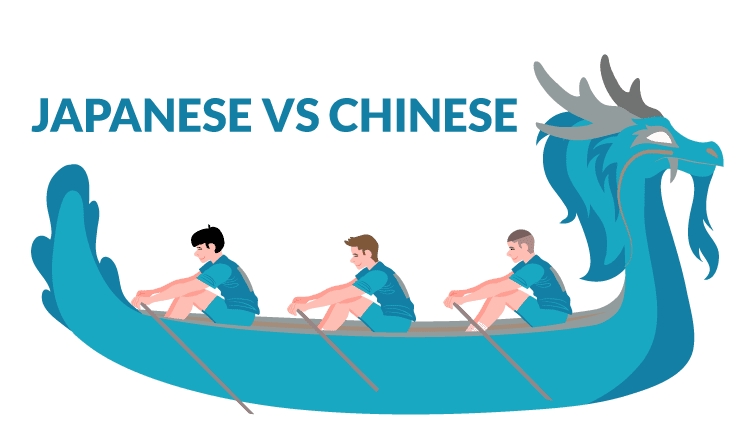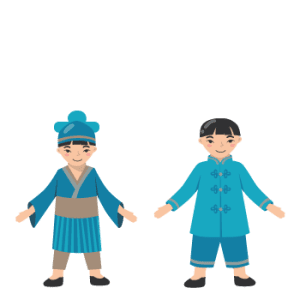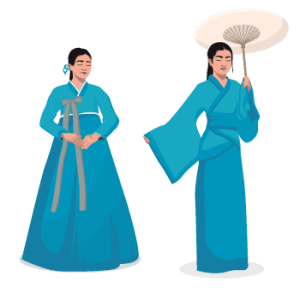Korean vs Chinese vs Japanese: Know the Differences

Do you speak more than one language? If so, which ones? Chinese, Japanese, and Korean are three of the most common languages worldwide, with many speakers located around the globe. While all three have their own unique set of complexities to them, they also have several similarities that make them very similar in some ways and very different in others. Please take a look at this guide to learn more about the differences between Korean vs. Chinese vs Japanese and what they mean to you!
General Overview of the Three Languages
Linguistically, Korean, Chinese, and Japanese are similar languages, but they have developed quite differently. They all fall under a family of Altaic languages and likely branched off from a common ancestor.
However, despite their similarities, there are many differences between each language. For instance, while all three use kanji/hanja (Chinese), only Koreans use hangul as their writing system. These differences also extend to grammar and pronunciation, among other aspects of language. While speakers of one language can learn another, it is not easy.
Some similarities can be found among them, such as using honorifics and using different levels of politeness depending on who you are speaking with. In addition, they all share basic greetings and can be used by native speakers when traveling or living abroad. Despite these similarities, however, learning one will not help you learn another.
To master any of these languages takes time and effort, just like learning any new language would take time and effort.The rich cultural tapestry of the Korean people finds expression not only in their history but also in their vibrant traditions, including Korean music, which serves as a testament to their artistic heritage.
Publications from esteemed institutions like Ewha Womans University Press play a crucial role in documenting and disseminating knowledge about Korean music, providing insights into its evolution and significance.
Furthermore, the linguistic diversity within Korea is reflected in the Gyeongsang and Chungcheong dialects, each carrying a unique linguistic flavor that adds depth to the cultural identity of the Korean people.
As a reflection of regional diversity, these dialects contribute to the mosaic of expressions that shape the dynamic cultural landscape of Korea, showcasing the harmonious blend of tradition and modernity.
Cultural and Linguistic Richness of Korea
The rich cultural tapestry of the Korean people finds expression not only in their history but also in their vibrant traditions, including Korean music, which serves as a testament to their artistic heritage. Publications from esteemed institutions like Ewha Womans University Press play a crucial role in documenting and disseminating knowledge about Korean music, providing insights into its evolution and significance.
Furthermore, the linguistic diversity within Korea is reflected in the Gyeongsang and Chungcheong dialects, each carrying a unique linguistic flavor that adds depth to the cultural identity of the Korean people. As a reflection of regional diversity, these dialects contribute to the mosaic of expressions that shape the dynamic cultural landscape of Korea, showcasing the harmonious blend of tradition and modernity.
The study of Asian languages, particularly focusing on the Korean alphabet and Japanese writing systems, reveals fascinating contrasts in their use and grammatical structures. The Korean alphabet, known as Hangul, is renowned for its scientific design and efficiency, allowing learners to quickly grasp its usage in daily life.
In contrast, Japanese writing employs three different scripts—Hiragana, Katakana, and Kanji—which each serve distinct functions within the language’s complex grammatical framework. For both Korean and Japanese, mastering these writing systems is essential for deep comprehension and practical communication in everyday settings, where nuances of language structure play a pivotal role in conveying meaning accurately and effectively.
Korean Language
In the 15th century, the Korean peninsula witnessed the development of a unique and complex native language, characterized by its intricate Korean scripts. Fast forward to the 20th century, English speakers began to explore the nuances of this difficult language, uncovering its rich history and cultural significance.
Today, in the 21st century, the study of Korean vocabulary continues to capture the interest of both English and European language enthusiasts. With the increasing global interactions, not only Korean speakers but also Chinese speakers find themselves drawn to deciphering Korean sentences, navigating the intricacies of the language through its distinct characters.
As these linguistic connections unfold, the exchange between English, European, and Chinese speakers serves as a testament to the enduring fascination with the Korean language and its evolution over centuries.
The Korean Language Variants
Korean is a language isolate; it has no related living language. It is spoken by about 70 million people in North and South Korea and overseas Korean communities. There are currently two standard varieties of Korean: North Korean Standard Korean, which uses a pure phonemic orthography, and South Korean Standard Korean, which incorporates particular distinctions in pronunciation between syllables that are not distinguished in standard spelling.
Both North and South Korea consider their standard varieties to be dialects of a single language because they use one standardized written form. However, they diverged from one another at different points. Additionally, many linguists refer to North Korean Standard Korean as North Korean and South Korean Standard Korean as South Korean.

Although most Koreans today speak only one variety, there are still some ethnic groups that speak different types of Korean, calling them dialects rather than separate languages. There is also a group of linguists who argue for three separate languages out of concern for political issues, but these claims have been discredited mainly among mainstream linguists.
Chinese Language
Chinese, which is spoken by more than 1.3 billion people, is a highly complex language that has been called one of the most challenging languages to learn. It has no relationship to any other language or family of languages and contains sounds used in no other tongue in history.
While Chinese has existed for around 2,000 years, written characters have been used for almost 5,000 years. While Mandarin Chinese is most common in mainland China (including Hong Kong), there are seven official dialects of spoken Chinese; many more are recognized as regional Chinese dialects/languages within China and different from each other so much that they might be mutually unintelligible even though they are understood by people who speak their local language.
Three major regional dialects of Chinese differ significantly from each other, but all share an affinity with Mandarin. To make things more complicated, Cantonese and Taiwanese are two additional major groups of Chinese, neither having anything to do with Mandarin at all! For those learning Chinese today, there is a simplified version and a traditional version of written Chinese.
Impact of Simplification on Chinese Literacy
Simplified versions of written Chinese characters were created in 1949 after the Communists took control from Nationalists led by Chiang Kai-shek; these new forms were intended to simplify literacy rates among non-elite citizens since only elite members of society had access to education before 1949.
Simplified versions reduced the number of strokes per character to 20% or less compared with 80% before simplification efforts. As a result, it was thought that if you learned simplified, you could read traditional without difficulty.
However, research shows that if you learn either system, you will have trouble reading both systems due to differences in stroke order and pronunciation rules between both systems. Learning how to write Chinese characters properly takes years of practice.

Japanese Language
Over 128 million people speak Japanese in Japan, along with around 9 million in other countries. The language has approximately 130 characters and 46 syllables, which can combine to produce an almost limitless number of words.
Japanese writing employs Kanji (characters imported from China), Katakana (modified Hiragana), and Hiragana itself. Additionally, a Latin alphabet called Romaji also appears. Some linguists consider these three systems as one language, while others view them as three separate languages due to their distinct grammar structures.
This is why learning Japanese may seem confusing at first because there are so many rules that must be followed to speak correctly. However, once you learn them, you will find yourself speaking like a native Japanese speaker.
When speaking Japanese, some particles are added to sentences for politeness or formality. These particles come after verbs or nouns as needed and change depending on what level of politeness is being expressed. For example, Watashi wa means I when being polite; however, Watashi wa becomes watashi ga when being more formal and polite.
The Differences Between the Languages
All three languages belong to one family of languages called Altaic. This group of languages also includes Turkic, Mongolian, and Tungusic. Several similarities between Korean, Chinese, and Japanese can be attributed to their common origin. However, each language also has its unique characteristics that make it different from its Altaic siblings. Here’s a look at some of those differences.
Differences in Writing Systems
The most apparent difference between these languages is in their featural writing systems. Both Korean and Japanese use a combination of ideographic symbols and phonetic symbols (i.e., symbols that represent pronunciation).
For example, the word “big” written in Chinese looks very similar to how it sounds, while “big” written in Japanese uses both phonetic characters and ideographic characters (which represent meaning rather than sound). But neither of these writing systems includes an alphabet as we have here in English.
To read or write any words or sentences written in them, you’ll need to learn to convert these into phonetic scripts using Hiragana for Japanese or Hangul for Korean, depending on which language you’re working with.
Chinese, on the other hand, does not use either of these scripts. Instead, it uses characters usually simplified versions of complex pictographs used thousands of years ago by ancient Chinese people. This system was developed over time as various regional dialects merged to form modern-day Mandarin Chinese.
Today, people write Mandarin in various ways depending on their location or native dialect, but all variations share one commonality—they all use the same pictographs found in ancient texts from thousands of years ago.
This makes reading and writing in Mandarin more difficult because students must memorize thousands upon thousands of different symbols before they can read anything!

How to Differentiate the Three Languages
There are three main languages spoken in East Asia- Japanese, Chinese and Korean. While all three languages share some similarities, there are also many differences between them. In this essay, we will look closely at how to differentiate between these three languages.
One of the most obvious ways to tell Japanese, Chinese, and Koreans apart is by their writing systems. Chinese uses a system of characters called hanzi, which are pictographic symbols that represent words or concepts. Korean use a system of hangul, which is more like alphabetical letters. And Japanese uses a combination of both hanzi, and two other scripts called katakana and hiragana.
Another way to tell these languages apart is by their pronunciation. Chinese is a tonal language, meaning the pitch of your voice can change the meaning of a word. For example, the word “ma” can mean either “mother” or “horse,” depending on the tone it is spoken in. Korean is not a tonal language, but it does have more vowel sounds than Japanese or Chinese. Japanese has a minimal number of vowel sounds compared to the other two languages.
The grammar of these three languages is also quite different. Chinese is a subject-prominent language, which means that the subject of a sentence usually comes before the object. Korean is a topic-prominent language, which means that the topic of a sentence usually comes before the subject. Japanese is a subject-object-verb language, which means that the subject and object traditionally come before the verb.
The Similarities Between the Languages
While there are many similarities between Korean, Chinese, and Japanese, each language has its unique features. As Korea, China and Japan continue to export popular culture worldwide, more and more people are exposed to their respective languages.
While most of them will understand one or two of these languages, it’s interesting to note that few ever consider how each differs from its counterparts. For starters, there are quite a few words shared by all three languages. For example, as with other East Asian cultures, respect is paramount to Koreans and Japanese; there isn’t just one word for thank you but several!
Words for body parts, such as “nose” or “eye,” exist similarly in Korean, Chinese, and Japanese. Additionally, specific sentence structures show another similarity among the languages.
Many sentence endings consist of reduplication. Reduplication is when something (typically a verb) is repeated to add emphasis. In English, we do not use recurrence much anymore, but in Korean vs. Chinese vs Japanese, it’s widespread. However, even if they share similar words and sentence structures, there are still significant differences between Korean, Chinese, and Japanese.
These differences include writing systems and grammar rules that make learning any of these languages difficult without learning at least one of its counterparts first.

A Quick Review of Their Histories
Chinese is the oldest of the three languages, with a history of over 3,000 years. It is the official language of China and Taiwan and is also spoken in Hong Kong, Macau, and many other countries. Chinese is a tonal language, which means that the meaning of a word can change depending on the tone in which it is spoken. There are four tones in Mandarin Chinese, and each tone has a different meaning. For example, the word “ma” can mean mother, horse, or hemp, depending on the tone.
Japanese, over 2,000 years old, is Japan’s official language, using three writing systems: hiragana, katakana, and kanji for syllables. In the 19th century, interest in linguistic diversity grew, leading to the study of Korean dialects and grammatical gender in Jilin province.
The standardization of language became a focal point, with efforts to establish a unified standard language intensifying. The historical roots of these linguistic endeavors date back to the 6th century, as the Korean peninsula witnessed the development of distinct dialects.
Harvard scholars conducted significant research, while Cambridge University Press’s “Korea Information – History” helped spread knowledge about the linguistic landscape.
Major South Korean publications like the Korea Herald enhance understanding of Korean language evolution across various provinces in the Republic of Korea.
Korean is the youngest of the three languages, with a history of around 1,500 years. Korean serves as the official language of North and South Korea and is also spoken in China, Japan, and the United States. As an agglutinative language, Korean forms words by combining multiple morphemes. For example, the word “haneulsaeng,” meaning “student,” consists of the following morphemes: “Han” (한), “eul” (을), “SAE” (생), and “ng” (ㄴ).
Chinese vs. Japanese vs. Korean Cultures
There are many similarities and differences between Chinese, Japanese, and Korean cultures. While similarities exist, such as family importance and respect for elders, significant differences arise in handling conflict and disagreement. Understanding these similarities and differences can foster better appreciation among people from Chinese, Japanese, and Korean cultures.
Chinese, Japanese, and Korean cultures emphasize family as society’s foundation, expecting members to support each other, especially in marriage and divorce.
In China, marriage is family-oriented, with arranged unions; in Japan, divorce is common, while in Korea, families intervene to prevent divorce.
Chinese, Japanese, and Korean cultures emphasize respect for elders, valuing their wisdom and experience, particularly in practicing filial piety.
Filial piety is the Confucian virtue of respect for one’s elders. In China, families take filial piety very seriously, expecting children to show great respect to their elders. Also, In Japan, although filial piety remains important, people do not emphasize it as strongly as in China. In Korea, while filial piety is less emphasized than in China and Japan, families still consider it a virtue.
One of the key differences between Chinese, Japanese, and Korean cultures is the way each culture handles conflict and disagreement. In China, the focus is on maintaining harmony and avoiding conflict. This is done by maintaining a hierarchy and avoiding direct confrontation. In Japan, the focus is on resolving conflict through compromise and consensus. In Korea, the focus is on maintaining relationships and avoiding conflict.
Challenges of Learning Chinese
Chinese languages, especially Mandarin and Cantonese, challenge English speakers with their complex tones and characters, complicating language learning efforts.
King Sejong created Hangul in the 15th century to boost literacy and foster national identity as an alternative to Chinese. For English speakers, learning Chinese is challenging, often seen as one of the hardest languages due to its tonal nature. Even for proficient language learners, deciphering the nuances of Chinese can be akin to unraveling a linguistic puzzle.
Conclusion
Each of these languages is as beautiful and complex as the other. They have similar grammatical structures, but even so, there are still notable differences that set them apart from one another. It’s also important to note that Korea, China, and Japan didn’t always exist in their current forms – they were changed by history. It’s fascinating to compare how each country has adapted its language over time, both to new elements and new rules. In any case, it doesn’t hurt to learn more about all three languages!
Frequently Asked Questions
East Asian languages including Chinese, Korean, and Japanese, each with distinct scripts and features, making them uniquely challenging and charming to learn.
Japanese, Chinese, and Korean are distinct languages with different grammar, vocabulary, and pronunciation, despite some similarities between Japanese and Korean.
Chinese characters are rectangular, while Japanese and Korean characters are rounder and often more complex, written left to right or top to bottom.
Korean and Japanese share similarities but differ in writing systems; Korean uses Hangul, while Japanese uses Kanji and has more complex grammar.
One factor to consider is the writing system. Chinese writing uses a logographic system, which means each character represents a word. This can be difficult for learners because there are thousands of characters to learn. Japanese writing uses a mix of logographic and syllabic writing, which can also be challenging. Korean writing uses an alphabet, which is typically easier for learners.




